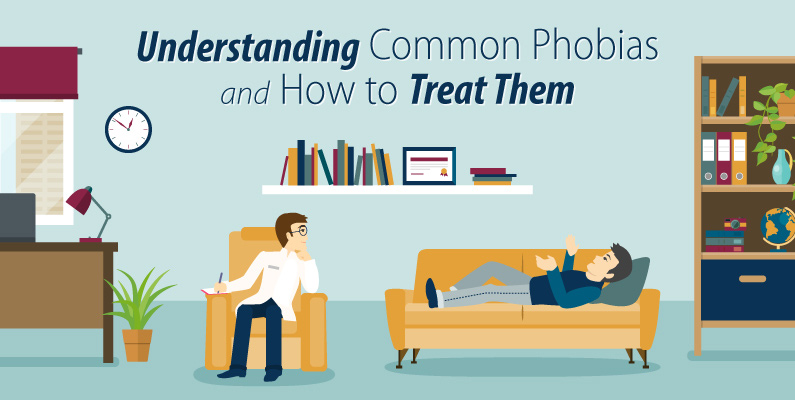Understanding Common Phobias and How to Treat Them
| 5 Min Read

It is normal for humans to experience fear. In fact, it can even be critical to our survival, activating the “fight or flight” response and allowing us to react quickly and protect ourselves if necessary. When fears are extreme, the field of psychology considers them phobias. A phobia is an intense fear of an object or situation that poses little or no actual danger, such as heights, snakes, or small spaces. While most phobias develop during childhood, they can also manifest in adults. People with phobias usually realize their fears are unfounded, yet struggle to control their reactions.
The terror and anxiety accompanying exposure to a feared object or situation can be overwhelming, leading individuals to avoid encounters at all costs. They might even change their lifestyle or inconvenience themselves—moving to avoid an apartment with an elevator because of a phobia of small spaces, or turning down a job in a high-rise building due to an extreme fear of heights.
While phobias may seem puzzling, they are actually quite common, and highly treatable. According to the Anxiety and Depression Association of America (ADAA), specific phobias affect 19 million adults, or 8.7% of the U.S. population. Furthermore, women are twice as likely to suffer from phobias than men. What are the most common phobias, and how do mental health professionals go about treating them?
Phobias: Types, Symptoms and More
There are three types of anxiety disorders that are phobias in the Diagnostic and Statistical Manual of Mental Disorders, Fifth Edition (DSM-V). Common specific phobias include:
- Those involving animals, including the fear of snakes, spiders, rodents, and dogs
- Those involving a person’s natural environment, such as a fear of heights, storms, water, and the dark
- Situational phobias triggered by specific situations such as being in enclosed spaces, travel via airplane, or driving across a bridge
- Phobias related to blood or injuries, triggered by potential injury, needles, or medical procedures
In addition to specific phobia, there is social phobia (or social anxiety disorder), which occurs when people have an intense fear of social situations in which they may be embarrassed or judged, and agoraphobia, which involves a fear of public places and open spaces.
While the symptoms associated with phobias can range from mild to severe, panic attacks are a common response, according to Mental Health America. The following are some of the physical symptoms of phobias, as reported by the ADAA:
- Difficulty breathing
- Racing or pounding heart
- Chest pain or tightness
- Trembling or shaking
- Feeling dizzy or lightheaded
- Hot or cold flashes
- Sweating
Phobias are also associated with emotional symptoms, such as:
- Overwhelming anxiety or panic
- An intense need to escape
- Feeling detached from yourself
- Fear of losing control
- Feeling of powerlessness
Individuals should likely consider treatment for phobias if they experience intense fear, anxiety or panic, as well as avoiding situations and locations because of fear. If this avoidance interferes with the functions of daily life and feelings of fear have persisted for at least six months, treatment may be necessary.
Treating Phobias
Depending on the type of phobia and the accompanying symptoms, mental health providers may suggest psychotherapy, medication, or a combination of both as treatment. No matter what the specific treatment approach is, the goal is to “reduce your anxiety and fear and to help you better manage your reactions to the object or situation that causes them,” the Mayo Clinic says. There are several psychotherapeutic approaches that can help with phobias. Regardless of the specific approach mental health professionals use, phobias can be managed and successfully treated.
Desensitization or Exposure Therapy
According to the Mayo Clinic, these treatments focus on “changing your response to the object or situation that you fear” through gradual and repeated exposure. Under the close supervision of a mental health professional, patients are exposed to what they fear in increments, until the situation no longer triggers panic or fear. This can be done through imagined exposure in which the patient mindfully explores the feared situation, or actual exposure that involves experiencing the fear in real life. In many cases, exposure therapy combines the two approaches.
Cognitive Behavioral Therapy
Cognitive Behavioral Therapy, or CBT, instructs people to identify their anxiety and replace it with realistic, grounded thoughts. It helps patients by teaching them various coping mechanisms and “alternative beliefs about your fears and the impact they have on your life,” according to the Mayo Clinic. It is important to note that cognitive behavioral therapy alone is uncommon for the treatment of phobias; instead, it is used in combination with other methods. WebMD states that other techniques like meditation, biofeedback and deep breathing exercises can also help patients with phobias overcome their symptoms.
Medications
When it comes to medications, physicians and mental health professionals prescribe various types as a way to control anxiety and panic. Medication is usually used along with psychotherapy if the initial therapeutic treatment is not effective on its own. The Mayo Clinic writes that beta blockers address “the stimulating effects of adrenaline on your body … [and] can be effective in decreasing symptoms when taken before an anticipated event.” Antidepressants called selective serotonin reuptake inhibitors (SSRIs) such as Celexa, Prozac or Zoloft are also commonly used. They “act on the chemical serotonin, a neurotransmitter in your brain that’s believed to influence mood.” Finally, sedatives called benzodiazepines, like Valium and Xanax, help patients relax by reducing the amount of anxiety they feel.
If you are interested in relevant topics in psychology like the ones covered here, consider Concordia University, St. Paul’s online Bachelor of Science in Psychology. This program equips students with the knowledge and tools necessary to excel in the field of psychology. You can learn more about this fully online degree, and others, at online.csp.edu.